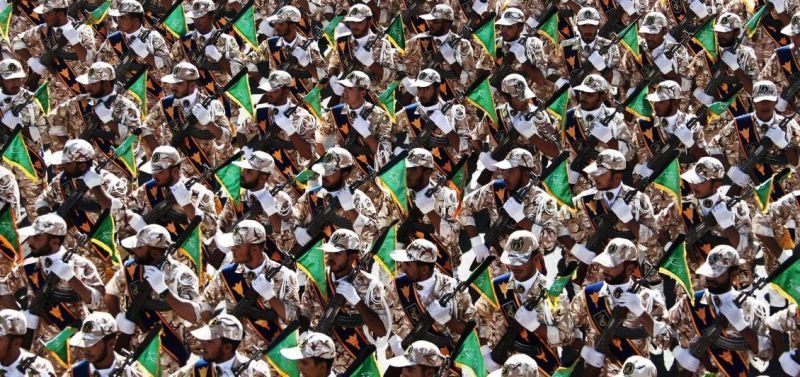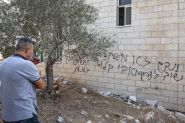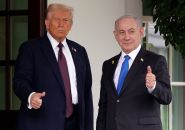- Home
- Arab World
- The Revolutionary Guards: Inside the Force Targeted by Israel

Troops of the Islamic Revolutionary Guard Corps at their annual parade in Tehran, on September 22, 2014. ©AFP
As part of its “Rising Lion” operation aimed at dismantling Iran’s nuclear program, Israel has dealt a major blow to the Islamic Revolutionary Guard Corps (IRGC), killing at least five senior officials, including the group’s top commander, General Hossein Salami.
The operation also targeted Iran’s ballistic missile program, which is largely overseen by the IRGC. According to the Israeli military, the strikes destroyed roughly a third of Iran’s surface-to-surface missile launchers. “More than 50 fighter jets and military aircraft conducted precision strikes and destroyed over 120 surface-to-surface missile launchers – about a third of the regime’s total launch capacity,” said Israeli army spokesperson Major General Effie Defrin on Monday.
With the IRGC now firmly in the international spotlight, one pressing question emerges: who are these elite forces, and what is their actual capacity?
Battling Enemies Inside and Out
The IRGC, also known as the Pasdaran, is a military and ideological force established in 1979, just months after Ayatollah Khomeini declared the Islamic Republic of Iran. Formed to protect the regime, the Guards operate under the direct authority of the Supreme Leader.
Their core mission: to defend the Islamic Republic and “preserve the revolution’s gains by confronting enemies both internal and external.” In line with that mandate, they have played a central role in violently suppressing domestic dissent and carrying out military operations abroad – including missile strikes on Israel, which the regime has openly called an “enemy to be wiped off the map.”
A Far-Reaching Military Network
Their power doesn’t come from numbers alone. Unlike Iran’s regular army, the Artesh, which counts around 420,000 troops, the IRGC operates as a parallel force. According to the United States Defense Intelligence Agency (DIA), they have roughly 190,000 active members divided across several branches: 150,000 in the ground forces, 20,000 in naval units, and 15,000 in aerospace divisions.
Adding to this is the Basij militia, an affiliated paramilitary volunteer force, bringing the total strength to approximately 640,000 personnel.
Among their most prominent units is the Quds Force, an elite division of roughly 5,000 fighters specializing in external operations. This force is central to Iran’s influence projection across the Middle East, especially in Lebanon, Syria, Iraq and Yemen.
Exporting the Revolution
Their influence grew substantially during the Iran-Iraq War (1980–1988), a conflict in which the Pasdaran gained experience, legitimacy and power. Over the decades, they extended their reach beyond Iran’s borders, gradually consolidating control over several Arab countries while exporting the revolutionary ideology of the Iranian Shia regime.
Within this framework, they have supported, armed, trained and provided intelligence assistance to numerous allied armed groups, playing a central role in forging a pro-Iranian Shiite axis across the Middle East.
Beyond a Military Force
Beyond their military role, the Pasdaran have emerged as a central force in Iran’s political, economic and energy sectors. They control vast segments of the national economy and wield considerable influence over the regime’s political decisions.
Through their conglomerate Khatam al-Anbia, they dominate the construction industry with more than 1,700 government contracts. In telecommunications, they hold major stakes in strategic companies such as Etemad-e-Mobin, which became the majority shareholder of the Telecommunication Company of Iran in 2009. Their influence also extends to transportation infrastructure, controlling nearly half of the country’s airports – including Tehran’s international airport.
A key event highlights this control: in the early 2000s, when President Mohammad Khatami’s administration intended to hand over the airport’s operation to a Turkish firm, the Pasdaran threatened to ground all flights unless the concession was awarded to them – clearly showing their power to impose their will on the government.
Furthermore, their influence extends into the banking sector through the Mehr Economic Institution, which operates 700 branches and serves 8 million clients. In the petrochemical industry, they hold stakes in Zagros Petrochemicals and Pars Petrochemical Company. Experts cited by the Jerusalem Post estimate they control over 57% of the country’s imports and around 30% of its non-oil exports. This economic power also allows them to circumvent international sanctions via a vast network of smuggling operations and shell companies.
In the energy sector, the Pasdaran are believed to control up to 50% of Iran’s oil exports – primarily destined for China – using a fleet of ghost tankers and offshore networks.
Fourteen financial institutions are now directly controlled by the IRGC and Supreme Leader Ali Khamenei. These centers of economic power play a key role in the systematic plundering of Iran’s economy and finance the IRGC’s activities and its subsidiaries. This information comes from The Rise of the Revolutionary Guards’ Financial Empire, published by the US representative office of the National Council of Resistance of Iran (NCRI).
Finally, their influence extends to the highest levels of the state with the Pasdaran consistently holding key positions in the government, parliament and public institutions.
Listed as a Terrorist Group by Washington
In 2019, the US designated the IRGC as a foreign terrorist organization. Washington accuses it of orchestrating attacks abroad and supporting Islamist groups hostile to Israel.
Against this backdrop, the Trump administration claimed responsibility for the targeted killing of Qassem Soleimani, the former commander of the Quds Force. He was killed in a US drone strike in Baghdad on January 3, 2020 – an operation that sharply escalated tensions between Tehran and Washington.
‘Rising Lion:’ The Last Nail in Their Coffin?
After the setbacks suffered by Hamas and Hezbollah – followed by the collapse of the Syrian regime – the “Rising Lion” operation appears to be the final blow to the pro-Iranian Shiite axis. By targeting and dismantling the leadership of the IRGC, Israel is striking at the heart of Tehran’s power projection apparatus. For Israel, weakening the Pasdaran in a lasting way has become a central strategic priority.
Read more





Comments